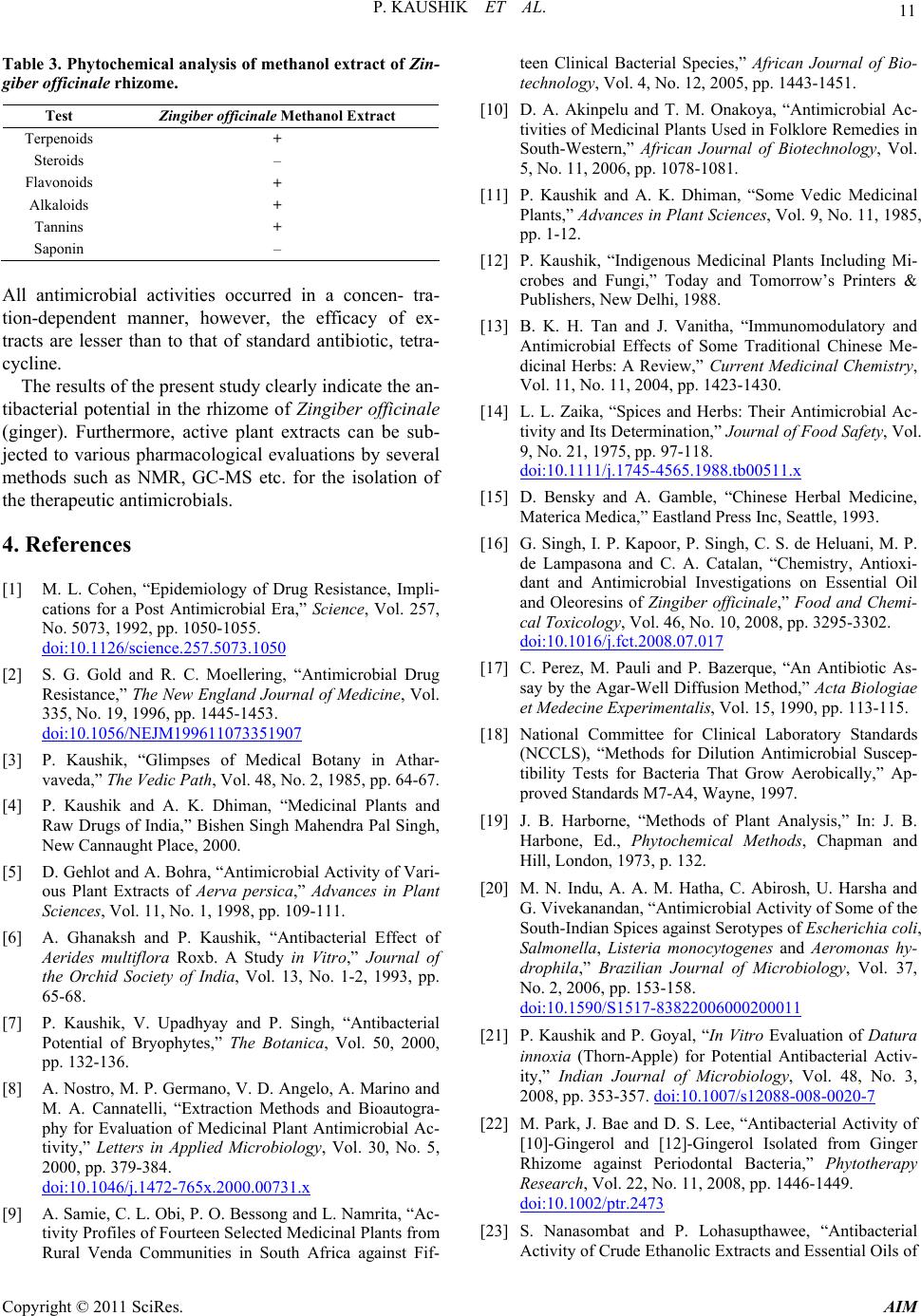
11
P. KAUSHIK ET AL.
Table 3. Phytochemical analysis of methanol extract of Zin-
giber officinale rh izome.
Test Zingiber offici nale Methanol Extract
Terpenoids +
Steroids –
Flavonoids +
Alkaloids +
Tannins +
Saponin –
All antimicrobial activities occurred in a concen- tra-
tion-dependent manner, however, the efficacy of ex-
tracts are lesser than to that of standard antibiotic, tetra-
cycline.
The results of the present study clearly indicate the an-
tibacterial potential in the rhizome of Zingiber officinale
(ginger). Furthermore, active plant extracts can be sub-
jected to various pharmacological evaluations by several
methods such as NMR, GC-MS etc. for the isolation of
the therapeutic antimicrobials.
4. References
[1] M. L. Cohen, “Epidemiology of Drug Resistance, Impli-
cations for a Post Antimicrobial Era,” Science, Vol. 257,
No. 5073, 1992, pp. 1050-1055.
doi:10.1126/science.257.5073.1050
[2] S. G. Gold and R. C. Moellering, “Antimicrobial Drug
Resistance,” The New England Journal of Medicine, Vol.
335, No. 19, 1996, pp. 1445-1453.
doi:10.1056/NEJM199611073351907
[3] P. Kaushik, “Glimpses of Medical Botany in Athar-
vaveda,” The Vedic Path , Vol. 48, No. 2, 1985, pp. 64-67.
[4] P. Kaushik and A. K. Dhiman, “Medicinal Plants and
Raw Drugs of India,” Bishen Singh Mahendra Pal Singh,
New Cannaught Place, 2000.
[5] D. Gehlot and A. Bohra, “Antimicrobial Activity of Vari-
ous Plant Extracts of Aerva persica,” Advances in Plant
Sciences, Vol. 11, No. 1, 1998, pp. 109-111.
[6] A. Ghanaksh and P. Kaushik, “Antibacterial Effect of
Aerides multiflora Roxb. A Study in Vitro,” Journal of
the Orchid Society of India, Vol. 13, No. 1-2, 1993, pp.
65-68.
[7] P. Kaushik, V. Upadhyay and P. Singh, “Antibacterial
Potential of Bryophytes,” The Botanica, Vol. 50, 2000,
pp. 132-136.
[8] A. Nostro, M. P. Germano, V. D. Angelo, A. Marino and
M. A. Cannatelli, “Extraction Methods and Bioautogra-
phy for Evaluation of Medicinal Plant Antimicrobial Ac-
tivity,” Letters in Applied Microbiology, Vol. 30, No. 5,
2000, pp. 379-384.
doi:10.1046/j.1472-765x.2000.00731.x
[9] A. Samie, C. L. Obi, P. O. Bessong and L. Namrita, “Ac-
tivity Profiles of Fourteen Selected Medicinal Plants from
Rural Venda Communities in South Africa against Fif-
teen Clinical Bacterial Species,” African Journal of Bio-
technology, Vol. 4, No. 12, 2005, pp. 1443-1451.
[10] D. A. Akinpelu and T. M. Onakoya, “Antimicrobial Ac-
tivities of Medicinal Plants Used in Folklore Remedies in
South-Western,” African Journal of Biotechnology, Vol.
5, No. 11, 2006, pp. 1078-1081.
[11] P. Kaushik and A. K. Dhiman, “Some Vedic Medicinal
Plants,” Advances in Plant Sciences, Vol. 9, No. 11, 1985,
pp. 1-12.
[12] P. Kaushik, “Indigenous Medicinal Plants Including Mi-
crobes and Fungi,” Today and Tomorrow’s Printers &
Publishers, New Delhi, 1988.
[13] B. K. H. Tan and J. Vanitha, “Immunomodulatory and
Antimicrobial Effects of Some Traditional Chinese Me-
dicinal Herbs: A Review,” Current Medicinal Chemistry,
Vol. 11, No. 11, 2004, pp. 1423-1430.
[14] L. L. Zaika, “Spices and Herbs: Their Antimicrobial Ac-
tivity and Its Determination,” Journal of Food Safety, Vol.
9, No. 21, 1975, pp. 97-118.
doi:10.1111/j.1745-4565.1988.tb00511.x
[15] D. Bensky and A. Gamble, “Chinese Herbal Medicine,
Materica Medica,” Eastland Press Inc, Seattle, 1993.
[16] G. Singh, I. P. Kapoor, P. Singh, C. S. de Heluani, M. P.
de Lampasona and C. A. Catalan, “Chemistry, Antioxi-
dant and Antimicrobial Investigations on Essential Oil
and Oleoresins of Zingiber officinale,” Food and Chemi-
cal Toxicology, Vol. 46, No. 10, 2008, pp. 3295-3302.
doi:10.1016/j.fct.2008.07.017
[17] C. Perez, M. Pauli and P. Bazerque, “An Antibiotic As-
say by the Agar-Well Diffusion Method,” Acta Biologiae
et Medecine Experimentalis, Vol. 15, 1990, pp. 113-115.
[18] National Committee for Clinical Laboratory Standards
(NCCLS), “Methods for Dilution Antimicrobial Suscep-
tibility Tests for Bacteria That Grow Aerobically,” Ap-
proved Standards M7-A4, Wayne, 1997.
[19] J. B. Harborne, “Methods of Plant Analysis,” In: J. B.
Harbone, Ed., Phytochemical Methods, Chapman and
Hill, London, 1973, p. 132.
[20] M. N. Indu, A. A. M. Hatha, C. Abirosh, U. Harsha and
G. Vivekanandan, “Antimicrobial Activity of Some of the
South-Indian Spices against Serotypes of Escherichia coli,
Salmonella, Listeria monocytogenes and Aeromonas hy-
drophila,” Brazilian Journal of Microbiology, Vol. 37,
No. 2, 2006, pp. 153-158.
doi:10.1590/S1517-83822006000200011
[21] P. Kaushik and P. Goyal, “In Vitro Evaluation of Datura
innoxia (Thorn-Apple) for Potential Antibacterial Activ-
ity,” Indian Journal of Microbiology, Vol. 48, No. 3,
2008, pp. 353-357. doi:10.1007/s12088-008-0020-7
[22] M. Park, J. Bae and D. S. Lee, “Antibacterial Activity of
[10]-Gingerol and [12]-Gingerol Isolated from Ginger
Rhizome against Periodontal Bacteria,” Phytotherapy
Research, Vol. 22, No. 11, 2008, pp. 1446-1449.
doi:10.1002/ptr.2473
[23] S. Nanasombat and P. Lohasupthawee, “Antibacterial
Activity of Crude Ethanolic Extracts and Essential Oils of
Copyright © 2011 SciRes. AIM